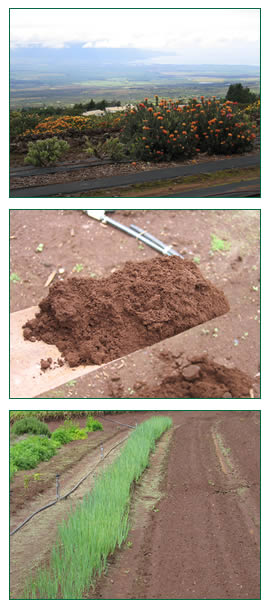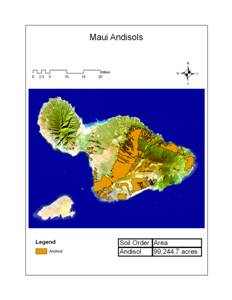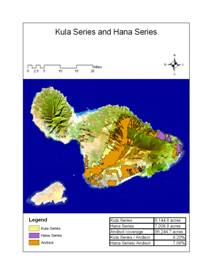Volcanic ash soils (Andisol)
Typical Characteristics:
- Parent Material: Volcanic soils, also known as Andisols, are formed from volcanic ash and cinder deposits. While most of the world’s volcanic soils are not highly weathered, there are notable exceptions on Maui.
- Mineralogy: Volcanic soils largely consist of non-crystalline (amorphous) minerals, such as allophone and imogolite.
- These minerals form strong bonds with organic matter. As a result, organic matter generally accumulates in the surface horizon.
- In addition to organic matter, volcanic soils may also contain high amounts of volcanic glass material with the possibility of amorphous iron and aluminum minerals.
- Physical Traits: Andisols are usually light and fluffy and are easily tilled. Like a sponge, these soils also hold a lot of water.
- Fertility: When not highly weathered, volcanic soils are typically very fertile soils. However, volcanic soils form strong complexes with phosphorus. When poorly managed, phosphorus can be limiting. Additionally, the amorphous minerals that dominate volcanic soil can generate an anion exchange capacity (AEC) when under acidic conditions and depleted in organic matter. Fertility problems may be corrected with additions of organic matter, lime and/or fertilizer amendments.
Volcanic soils of Maui:
Glassy, dry volcanic ash soil (Vitritorrand)
- Alae Series
- Oanapuka Series
Hot, dry volcanic ash soil (Haplotorrand)
Moist/dry volcanic ash soil (Haplustand)
- Io Series
- Kaipoipoi Series
- Kula Series
- Laumaia Series
- Oli Series
- Olinda Series
- Pane Series
- Puu Pa Series
- Ulupalakua Series
Volcanic ash soil with very high water retention (Hydrudand)
- Hana Series
- Kailua Series
- Honomanu Series
Unique Characteristics of Volcanic Ash Soils of Maui County:
Although there are several different types of volcanic soils on Maui, we will discuss two soils that are agriculturally significant.
- Moderately weathered volcanic ash soil
- Highly weathered volcanic ash soil.
The Kula Series is a prime example of a moderately weathered volcanic soil on Maui that is fertile.
- Location: The Kula series can be found in the uplands near Waiakoa. In total, this series occupies approximately 8,800 acres of land on Maui Island. The approximate elevation is between 2,000 and 3,500 feet.
- Texture: Loam
- Rainfall and Temperature: The mean annual rainfall for the Kula Series is between 25 and 40 inches, and the mean annual temperature is 66 degrees F.
- Slope: Gentle to steep slopes
- Parent material: The parent material of the Kula Series is volcanic ash that was deposited above moderately weathered andesite and basalt.
- Depth: The typical soil layer extends 8 inches, while the depth of the subsoil is 46 inches.
- Physical Traits: Kula soil has good drainage, with moderately rapid permeability and medium runoff.
- Color of surface horizon: Dark reddish-brown
- Fertility: While the Kula Series tends to have a high CEC and nutrient availability, irrigation may be required.
- Acidity: Slightly acid to neutral
- Natural vegetation: Naturally, the Kula Series supports grasses and native tree species.
- Crops: In cultivation, the Kula Series is used for the production of vegetable crops, flower and pastureland.
- Related soil series: Kaipoioi, Pane, and Kamaole series.
Depth (cm) |
% C |
% N |
Ca (cmol/kg) |
Mg (cmol/kg) |
K
(cmol/kg) |
Sum cations
(cmol/kg) |
0-9 |
17.87 |
1.547 |
33.8 |
13.8 |
4.8 |
106.7 |
9-15 |
14.28 |
1.328 |
34.5 |
9.5 |
4.1 |
96.4 |
15-62 |
13.92 |
0.676 |
3.7 |
0.8 |
1.2 |
146.5 |
62-98 |
13.13 |
|
5.9 |
1.1 |
3.5 |
149.1 |
98-130 |
11.55 |
|
12.7 |
0.7 |
2.4 |
132.0 |
Depth (cm) |
Sum Bases
(cmol/kg) |
Extr. Al
(cmol/kg) |
ECEC
(cmol/kg) |
Base Sat (%) |
Al Sat
(%) |
pH (water) |
pH (KCl) |
0-9 |
52.4 |
|
|
49 |
|
6.3 |
5.5 |
9-15 |
48.1 |
|
|
50 |
|
6.2 |
5.5 |
15-62 |
5.7 |
3.4 |
9.1 |
4 |
37 |
5.6 |
4.7 |
62-98 |
10.5 |
5.2 |
15.7 |
7 |
33 |
5.5 |
4.6 |
98-130 |
15.8 |
3.1 |
18.9 |
12 |
16 |
5.5 |
4.7 |
-- data was not taken
Highly Weathered Volcanic Soil
 |
| Photo by Tai McClellan |
The Hana Series is a characteristic highly weathered, infertile volcanic soil.
- Location: The Hana Series is located on the windward side of East Maui, and it occupies a land area of approximately 8,000 acres. The elevation at which you will find this soil is between sea level and in the uplands of 1,200 ft.
- Texture: Silty clay loam
- Rainfall and Temperature: The average annual rainfall is between 80 and 150 inches, and the average temperature is 73 degrees F.
- Slope: Gently to moderately steep
- Parent Material: The Hana Series was derived from volcanic ash that was deposited over cinders and `a`a lava flows. The depth of the soil profile may extend from 27 to 40 inches.
- Depth: While the surface soil is typically 12 inches, the subsoil extends 22 inches.
- Physical Traits: The surface may be very rocky depending upon the location. The soil has good drainage, with moderately rapid permeability and medium runoff.
- Color of surface horizon: Dark brown/dark grayish brown
- Fertility: The Hana Series is typically deficient in nutrients such as phosphorus.
- Acidity: Strongly to medium acidity
- Natural vegetation: Grasses and tree species.
- Agriculture: Pasture.
- Related Soil Series: Honomanu Series
Highly Weathered Volcanic Soil vs. Moderately Weathered Volcanic Soil
The major differences between a highly weathered soil, such as the Honomanu Series (Hana’s sister series) and a moderately weathered soil, such as the Kula Series is highlighted in the following table. The Honomanu Series is acidic and depleted in plant nutrients such as calcium, whereas the Kula Series is slightly acidic and rich in calcium.
|
Honomanu Series |
Kula Series |
Depth (cm) |
Ca |
pH water |
ECEC |
Depth (cm) |
Ca |
pH water |
ECEC |
0-5 |
1.9 |
4.1 |
|
0-9 |
33.8 |
6.3 |
|
5-14 |
0.3 |
3.8 |
2.3 |
9-15 |
34.5 |
6.2 |
|
14-32 |
0.1 |
4.2 |
0.7 |
15-62 |
3.7 |
5.6 |
9.1 |
32-53 |
0.1 |
4.8 |
0.6 |
62-98 |
5.9 |
5.5 |
15.7 |
53-68 |
0.1 |
5.3 |
|
98-130 |
12.7 |
5.5 |
18.9 |
|



